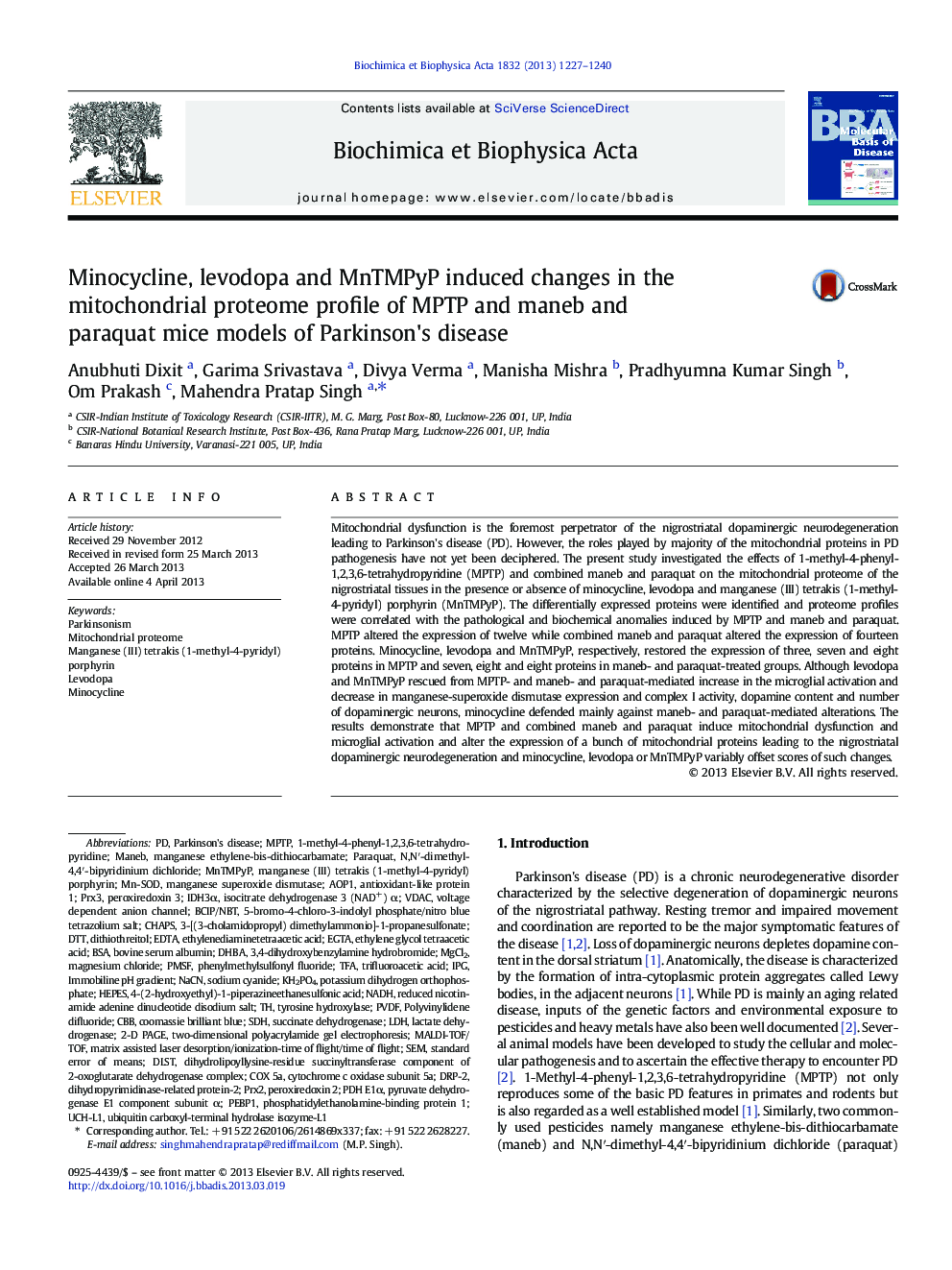| Article ID | Journal | Published Year | Pages | File Type |
|---|---|---|---|---|
| 8260902 | Biochimica et Biophysica Acta (BBA) - Molecular Basis of Disease | 2013 | 14 Pages |
Abstract
Mitochondrial dysfunction is the foremost perpetrator of the nigrostriatal dopaminergic neurodegeneration leading to Parkinson's disease (PD). However, the roles played by majority of the mitochondrial proteins in PD pathogenesis have not yet been deciphered. The present study investigated the effects of 1-methyl-4-phenyl-1,2,3,6-tetrahydropyridine (MPTP) and combined maneb and paraquat on the mitochondrial proteome of the nigrostriatal tissues in the presence or absence of minocycline, levodopa and manganese (III) tetrakis (1-methyl-4-pyridyl) porphyrin (MnTMPyP). The differentially expressed proteins were identified and proteome profiles were correlated with the pathological and biochemical anomalies induced by MPTP and maneb and paraquat. MPTP altered the expression of twelve while combined maneb and paraquat altered the expression of fourteen proteins. Minocycline, levodopa and MnTMPyP, respectively, restored the expression of three, seven and eight proteins in MPTP and seven, eight and eight proteins in maneb- and paraquat-treated groups. Although levodopa and MnTMPyP rescued from MPTP- and maneb- and paraquat-mediated increase in the microglial activation and decrease in manganese-superoxide dismutase expression and complex I activity, dopamine content and number of dopaminergic neurons, minocycline defended mainly against maneb- and paraquat-mediated alterations. The results demonstrate that MPTP and combined maneb and paraquat induce mitochondrial dysfunction and microglial activation and alter the expression of a bunch of mitochondrial proteins leading to the nigrostriatal dopaminergic neurodegeneration and minocycline, levodopa or MnTMPyP variably offset scores of such changes.
Keywords
PEBP1PMSFMPTPVDACCBBTFAEGTADHBASDHPrx2UCH-L1DTTphosphatidylethanolamine-binding protein 1Prx3MgCl2dlSTNaCNPVDFHEPESKH2PO4MnTMPyPDRP-21-methyl-4-phenyl-1,2,3,6-tetrahydropyridine2-D PAGE3-[(3-cholamidopropyl) dimethylammonio]-1-propanesulfonate4-(2-hydroxyethyl)-1-piperazineethanesulfonic acidBCIP/NBTBSACoomassie Brilliant BlueIPGMALDI-TOF/TOFMn-SODbovine serum albuminEDTAethylene glycol tetraacetic acidEthylenediaminetetraacetic acidTrifluoroacetic acidtwo-dimensional polyacrylamide gel electrophoresisParkinson's diseasetyrosine hydroxylasestandard error of meanspolyvinylidene difluoridedithiothreitolmanganese superoxide dismutasesuccinate dehydrogenaseSodium cyanidephenylmethylsulfonyl fluoridelactate dehydrogenaseLDHlevodopaManebSEMMinocyclineNADHParaquatParkinsonismperoxiredoxin 3Peroxiredoxin 2Mitochondrial proteomeCHAPSvoltage dependent anion channelMagnesium chloride
Related Topics
Life Sciences
Biochemistry, Genetics and Molecular Biology
Ageing
Authors
Anubhuti Dixit, Garima Srivastava, Divya Verma, Manisha Mishra, Pradhyumna Kumar Singh, Om Prakash, Mahendra Pratap Singh,
